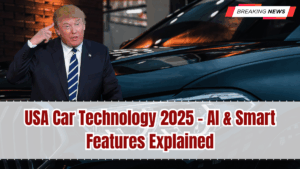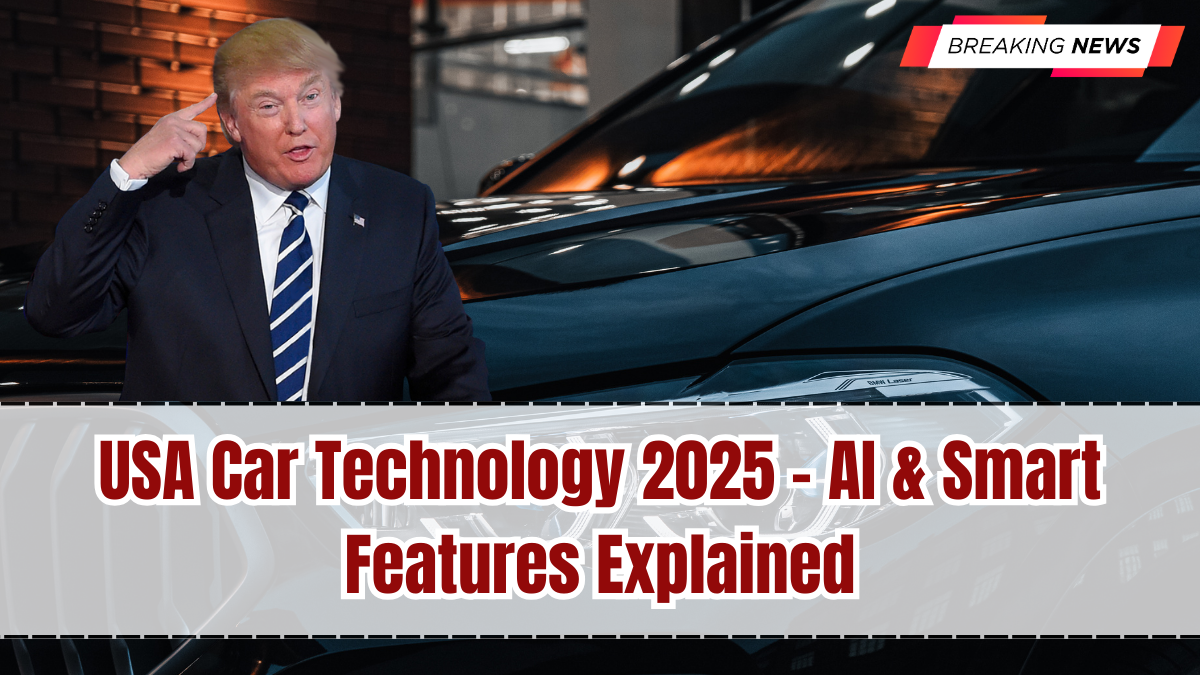The USA Car Technology 2025 landscape is redefining how Americans drive, commute, and interact with vehicles. No longer just machines of steel and fuel, cars in 2025 are now highly connected, AI-driven companions designed to keep drivers safe, informed, and entertained.
From autonomous driving features to AI-powered assistants, smart technology is making vehicles more intuitive than ever. For drivers, this means enhanced safety, improved fuel efficiency, and greater convenience. Automakers are racing to integrate the latest innovations, reshaping both the luxury and mass-market segments.
So, what are the most exciting smart features available in 2025, and how are they changing the driving experience in the USA?

How Is AI Shaping Car Technology in 2025?
Artificial Intelligence (AI) is at the heart of modern car technology. Vehicles now use AI to process massive amounts of real-time data from sensors, cameras, and GPS. This allows them to predict road conditions, assist with navigation, and even detect potential hazards before they occur.
AI also powers driver-assistance systems such as lane-keeping, adaptive cruise control, and automatic braking. In 2025, some advanced systems can even suggest alternative routes to avoid traffic or weather hazards, making driving safer and smoother.
AI-driven personalization is another breakthrough—cars can now adjust seat positions, climate control, and entertainment preferences automatically based on the driver’s profile.
What Smart Features Do Modern Cars Offer?
Smart features in 2025 are designed to make driving more enjoyable and connected.
-
Voice Assistants: Cars now come with built-in assistants like Alexa Auto, Google Assistant, or proprietary AI that respond to natural voice commands.
-
Augmented Reality Dashboards: AR overlays project navigation and speed data directly on the windshield.
-
Connected Apps: Drivers can remotely lock, unlock, or start their cars using smartphones or wearables.
-
Over-the-Air Updates: Software upgrades are delivered wirelessly, keeping cars up-to-date without visiting a dealership.
These features turn the car into an intelligent hub, much like a smartphone on wheels.
How Are Cars Becoming Safer With Technology?
Safety remains a top priority in 2025.
Cars are now equipped with AI-based predictive safety systems that monitor driver behavior, detect fatigue, and issue alerts. Emergency braking systems can stop the vehicle automatically if a collision is imminent. Blind-spot monitoring and cross-traffic alerts help prevent accidents during lane changes or parking.
In luxury models, 360-degree camera systems and driver attention monitors are standard, while mass-market vehicles are also adopting similar features thanks to cost reductions in technology.
Are Autonomous Driving Features Widely Available?
Yes, autonomous features are more widespread in 2025, although fully self-driving cars are not yet mainstream.
Most vehicles now offer Level 2 or Level 3 autonomy, where the car can manage tasks like steering, acceleration, and braking under specific conditions. Tesla, GM’s Super Cruise, and Ford’s BlueCruise are leading these advancements.
Autonomous highway driving is becoming common, but city driving still requires human oversight. Regulations continue to evolve, but the technology is advancing rapidly.
How Is Car Technology Improving Connectivity?
Cars are now more connected than ever before.
5G-enabled vehicles allow real-time communication with other cars, traffic systems, and cloud platforms. This connectivity improves navigation, enables traffic predictions, and supports Vehicle-to-Everything (V2X) systems, where cars communicate with infrastructure like traffic lights.
Entertainment is also evolving. Streaming services, gaming options, and personalized media libraries are seamlessly integrated into infotainment systems. Passengers can enjoy connected experiences similar to being at home.
Are Electric Vehicles Driving Innovation in Tech?
Yes, EVs are accelerating the pace of innovation.
Electric cars rely heavily on smart technology to optimize range, monitor battery health, and assist in charging. Many EVs now feature smart charging systems that suggest optimal times to plug in based on energy grid demand and pricing.
Tesla, Rivian, Lucid, and traditional automakers are using AI to fine-tune regenerative braking, improve efficiency, and extend battery life. EV owners benefit from apps that track charging locations and provide real-time availability updates.
What Challenges Exist With Car Technology in 2025?
Despite progress, challenges remain.
Cybersecurity is a growing concern as connected cars become targets for hackers. Automakers are investing heavily in encryption and secure networks to protect drivers’ data. Affordability is another issue—many smart features are standard in luxury cars but optional or expensive in budget models.
Finally, public trust in autonomous driving remains limited, as some drivers are cautious about handing control to AI, especially in complex urban environments.
Conclusion
The USA Car Technology 2025 era shows how vehicles are evolving into smart, connected machines. AI, augmented reality, autonomous features, and EV innovations are making driving safer, more efficient, and more personalized.
While challenges like cybersecurity and costs remain, the benefits of smart technology far outweigh the hurdles. For American drivers, cars in 2025 are not just vehicles—they’re intelligent companions shaping the future of mobility.
FAQs
What are the top AI features in cars in 2025?
Lane assist, adaptive cruise control, predictive navigation, and driver fatigue monitoring.
Do all cars now have smart dashboards?
Not all, but AR dashboards and connected infotainment systems are becoming more common across brands.
Are autonomous cars legal in the USA in 2025?
Partially—Level 2 and Level 3 autonomy are widely available, while fully autonomous cars remain in testing.
How do EVs use smart technology?
EVs feature smart charging, regenerative braking, and AI battery management for better performance.
What challenges does car technology face?
Cybersecurity risks, affordability, and limited trust in full autonomy are key challenges.
Click here to know more.
